mhow much does your diesel contaminate?
Page 35
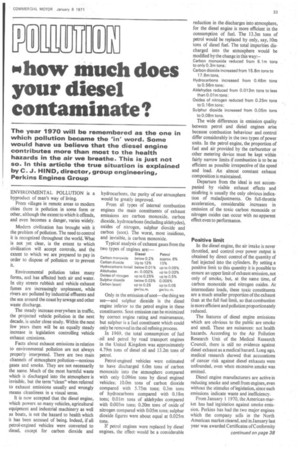
Page 37
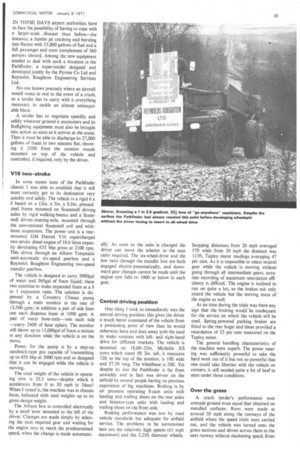
Page 38
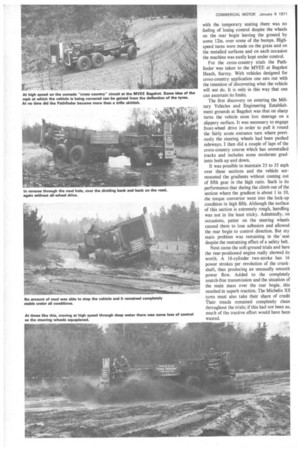
Page 39
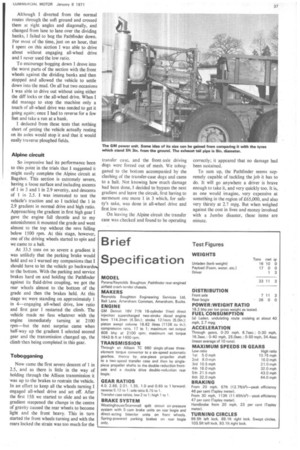
Page 40
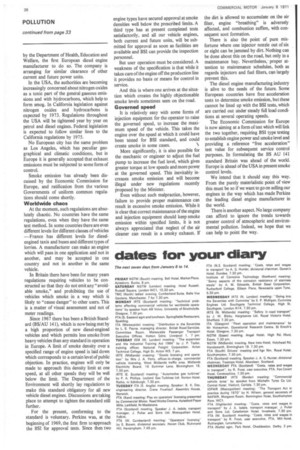
If you've noticed an error in this article please click here to report it so we can fix it.
ENVIRONMENTAL POLLUTION is a byproduct of man's way of living.
From villages in remote areas to modern cities there is pollution in some form or other, although the extent to which it offends, and even becomes a danger, varies widely.
Modern civilization has brought with it the problem of pollution. The need to control it is recognized throughout the world. What is not yet clear, is the extent to which civilization will accept controls, and the extent to which we are prepared to pay in order to dispose of pollution or to prevent it.
Environmental pollution takes many forms, and has affected both air and water. In city streets rubbish and vehicle exhaust fumes are increasingly unpleasant, while rivers are polluted by industrial effluents and the sea around the coast by sewage and other waste discharge.
The steady increase everywhere in traffic, the projected vehicle pollution in the next decade, is under close study. Within the next few years there will be an equally steady increase in legislation controlling vehicle exhaust emissions.
Facts about exhaust emissions in relation to environmental pollution are not always properly interpreted. There are two main channels of atmosphere pollution—noxious gases and smoke. They are not necessarily the same. Much of the most harmful waste which is discharged into the atmosphere is invisible, but the term "clean" when referred to exhaust emissions usually and wrongly means cleanliness in a visual sense.
It is now accepted that the diesel engine, which powers so many vehicles, agricultural equipment and industrial machinery as well as boats, is not the hazard to health which it has been accused of being. Indeed, if all. petrol-enned vehicles were converted to diesel, except for carbon dioxide and hydrocarbons, the purity of our atmosphere would be greatly improved.
From all types of internal combustion engines the main constituents of exhaust emissions are carbon monoxide. carbon dioxide, hydrocarbons (including aldehydes), oxides of nitrogen, sulphur dioxide and carbon (soot). The worst, most insidious, and invisible, is carbon monoxide.
Typical analysis of exhaust gases from the two types of engines are:— Diesel Petrol
Carbon monoxide below 0.2% approx. 6% Carbon dioxide Up to 12% 10% Hydrocarbons (total) below 0.01% up to 0.05% Aldehydes ay. 0.002% up to 0.03% Oxides of nitrogen up to 0.25% up to 0.5% Sulphur dioxide below 0.03% 0.008% Carbon (soot) up to 0.25 up to 0.05 gwicu.m. gwicu.m.
Only in the emission of soot—the thing we see—and sulphur dioxide is the diesel engine inferior to the petrol engine in these constituents. Soot emission can be minimized by correct engine rating and maintenance, but sulphur is a fuel constituent which could only be removed in the oil refining process.
In 1969, the total consumption of fuel • oil and petrol by road transport engines in the United Kingdom was approximately 4.79m tons of diesel oil and 13.2m tons of petrol.
Petrol-engined vehicles were estimated to have discharged 6.0m tons of carbon monoxide into the atmosphere compared with only 0.096m tons by diesel engined vehicles: 10.0m tons of carbon dioxide compared with 5.75m tons; 0,3m tons of hydrocarbons compared with 0.18m tons; 0.01m tons of aldehydes compared with 0.003m tons; 0.20m tons of oxide of nitrogen compared with 0.05m tons; sulphur dioxide figures were about equal at 0.025m tons.
If petrol engines were replaced by diesel engines, the effectwould be a considerable
reduction in the discharges into atmosphere, for the diesel engine is more efficient in the consumption of fuel. The 13.3m tons of petrol would be replaced by only, say, 10m tons of diesel fuel. The total impurities discharged into the atmosphere would be modified by the change in this way:— Carbon monoxide reduced from 6.1m tons to only 0.3m tons:
Carbon dioxide increased from 15.8m tons to 17.8m tons.
Hydrocarbons increased from 0.48m tons to 0.56m tons;
Aldehydes reduced from 0.013m tons to less than 0.01m tons:
Oxides of nitrogen reduced from 0.25m tons to 0.16m tons; Sulphur dioxide increased from 0.05m tons to 0.08m tons.
The wide differences in emission quality between petrol and diesel engines arise because combustion behaviour and control differ considerably in the two types of power units. In the petrol engine, the proportion of fuel and air provided by the carburettor or other metering device must be kept within fairly narrow limits if combustion is to be as efficient as possible irrespective of the speed and load. An almost constant exhaust composition is maintained.
Departure from the ideal is not accompanied by visible exhaust effects and misfiring is usually the only obvious indication of maladjustments. On full-throttle acceleration, considerable increases in emission of the toxic carbon monoxide or nitrogen oxides can occur with no apparent effect even to performance.
Positive limit
In the diesel engine, the air intake is never throttled, and control over power output is obtained by direct control of the quantity of fuel injected into the cylinders. By setting a positive limit to this quantity it is possible to ensure an upper limit of exhaust emission, not only of smoke,' but, at the same time, of carbon monoxide and nitrogen oxides. At intermediate loads, these toxic constituents are a much smaller proportion of the exhaust than at the full fuel limit, so that combustion is more efficient and pollution proportionately reduced.
The features of diesel engine emissions which are obvious to the public are smoke and smell. These are nuisances: not health hazards. According to the Air Pollution Research Unit of the Medical Research Council, there is still no evidence against diesel exhaust as a medical hazard. Long ago, medical research showed that accusations of cancer risk against diesel exhausts were unfounded, even when excessive smoke was emitted.
Diesel engine manufacturers are active in reducing smoke and smell from engines, even without the stimulus of legislation, since such emissions indicate waste and inefficiency.
From January 1 1970, the American market has had legislation against smoke emission. Perkins has had the two major engines which the company sells in the North American market cleared, and in January last year was awarded Certificates of Conformity IN THESE DAYS airport authorities have to face the possibility of having to cope with a larger-scale disaster than before—for instance, a Jumbo jet crashing and bursting into flames with 35,000 gallons of fuel and a full passenger and crew complement of 360 persons aboard. Among the new equipment needed to deal with such a situation is the Pathfinder, a super-tender designed and developed jointly by the Pyrene Co Ltd and Reynolds Boughton Engineering Services Ltd.
No one knows precisely where an aircraft would come, to rest in the event of a crash, so a tender has to carry with it everything necessary to tackle an almost unimaginable blaze.
A tender has to negotiate speedily and safely whatever ground it encounters and its firefighting equipment must also be brought into action as soon as it arrives at the scene. Then it must be able to discharge its 27,000 gallons of foam in two minutes flat, throwing it 250ft from the monitor nozzle mounted on top of the vehicle and controlled, if required, only by the driver.
V1I3 two-stroke In some recent tests of the Pathfinder chassis I was able to establish that it will most certainly get to its destination very quickly and safely. The vehicle is a rigid 6 x 6 based on a 12in. x 3in. x 0.5in. pressedsteel frame mounted on Scammell driving axles by rigid walking-beams and a Scammell driven-steering-axle, mounted through the conventional Scammell coil and wishbone suspension. The power unit is a rearmounted GM Detroit V16 supercharged two-stroke diesel engine of 18.6 litres capacity developing 635 bhp gross at 2100 rpm. This drives through an Allison Torqmatic semi-automatic six-speed gearbox and a Reynolds Boughton Engineering two-speed transfer gearbox.
The vehicle is designed to carry 3000gal of water and 360gal of foam liquid; these two combine to make expanded foam at a 9 to I expansion ratio. The solution is dispensed by a Coventry Climax pump through a main monitor at the rate of 13,500 gpm; in addition a pair of side lines can each dispense foam at 1000 gpm. A pair of water hose-reels---one each side —carry 240ft of hose apiece. The monitor will throw up to 15,000gal of foam a minute in any direction while the vehicle is on the move.
Power for the pump is by a step-up. sandwich-type pto capable of transmitting up to 450 bhp at 3000 rpm and so designed that it can be engaged while the vehicle is moving.
The total weight of the vehicle in operating trim is 33.5 tons—despite which it accelerates from 0 to 50 mph in 34sec! When I tested it, the machine was in chassis form, ballasted with steel weights up to its gross design weight.
The Allison box is controlled electrically by a small lever mounted to the left of the driver. Changes are made simply by selecting the next required gear and waiting for the engine revs to reach the predetermined speed, when the change is made automatic
ally. As soon as the ratio is changed the driver can move the selector to the next ratio required. The six-wheel-drive and the low ratio through the transfer box are both engaged electro-pneumatically, and downward gear changes cannot be made until the engine rpm falls to 1000 or below in each gear.
Central driving position
One thing I took to immediately was the central driving position: this gives the driver a much better command of the vehicle from a positioning point of view than he would otherwise have and does away with the need to make versions with leftand right-hand drive for different markets. The vehicle is mounted on 18,00-251n. Michelin XS tyres which stand 5ft 3in. tall; it measures 12ft to the top of the monitor, is 1011 wide and 37.3ft long. The wheelbase is 20ft. Yet despite its size the Pathfinder is far from unwieldy and in fact was driven on the• airfield by several people having no previous experience of big machines. Braking is by air pressure operating S-earn units with leading and trailing shoes on the rear axles and bisector-type units with leading and trailing shoes on the Tront axle.
Braking performance was low by road vehicle standards but adequate for airfield service. The problems to be surmounted here are the relatively high speeds (65 mph maximum) and the 5.25ft diameter wheels. Stopping distances from 20 mph averaged 57ft while from 30 mph the distance was 113ft, Tapley meter readings averaging 47 per cent. As it is impossible to select neutral gear while the vehicle is moving without going through all intermediate gears, accurate recording of maximum retardation efficiency is difficult. The engine is inclined to run on quite a lot, so the brakes not only retard the vehicle but the moving mass of the engine as well.
At no time during the trials was there any sign that the braking would be inadequate for the service on which the vehicle will be used. Spring-powered parking brakes are fitted to the rear bogie and these provided a retardation of 23 per cent measured on the Tapley meter.
The general handling characteristics of the machine were superb. The power steering was sufficiently powerful to take the hard work out of it but not so powerful that one could take liberties with the vehicle on corners; it still needed quite a bit of beef to steer under those conditions.
Over the grass A crash tender's performance over unmade ground must equal that obtained on metalled surfaces. Runs were made at around 50 mph along the runways of the airfield where the speed trials were carried out, and the vehicle was turned onto the grass sections and driven across them to the next runway without slackening speed. Even with the temporary seating there was no feeling of losing control despite the wheels on the rear bogie leaving the ground by some 12in. over some of the bumps. Highspeed turns were made on the grass and on the metalled surfaces and on each occasion the machine was easily kept under control.
For the cross-country trials the Pathfinder was taken to the MVEE at Bagshot Heath, Surrey. With vehicles designed for cross-country application one sets out with the intention of discovering what the vehicle will not do. It is only in this way that one can ascertain its limits.
The first discovery on entering the Military Vehicles and Engineering Establishment grounds at Bagshot was that on sharp turns the vehicle soon lost steerage on a slippery surface. It was necessary to engage front-wheel drive in order to pull it round the fairly acute entrance turn where previously the steering wheels had been pushed sideways. I then did a couple of laps of the cross-country course which has unmetalled tracks and includes some moderate gradients both up and down.
It was possible to maintain 25 to 35 mph over these sections and the vehicle surmounted the gradients without coming out of fifth gear in the high ratio. Such is its performance that during the climb out of the section where the gradient is about 1 in 10, the torque convertor went into the lock-up condition in high fifth. Although the surface of this section is extremely rough, handling was not in the least tricky. Admittedly, on occasions, patter on the steering wheels caused them to lose adhesion and allowed the rear bogie to control direction. But my main problem was remaining in the ' seat despite the restraining effect of a safety belt.
Next came the soft-ground trials and here the rear-positioned engine really showed its worth. A 16-cylinder two-stroke has 16 power strokes per revolution of the crankshaft, thus producing an unusually smooth power flow. Added to the completely snatch-free transmission and the situation of the main mass over the rear bogie, this resulted in superb tractidn. The Michelin XS tyres must also take their share of credit Their treads remained completely clean throughout the trials; if this had not been so, much of the tractive effort would have been wasted.
Although I diverted from the normal routes through the soft ground and crossed them at right angles and diagonally, and changed from lane to lane over the dividing banks, I failed to bog the Pathfinder down. For most of the time, just on an hour, that I spent on this section I was able to drive about without engaging all-wheel drive and I never used the low ratio.
To encourage bogging down I drove into the worst parts of the section with the front wheels against the dividing banks and then stopped and allowed the vehicle to settle down into the mud. On all but two occasions I was able to drive out without using either the diff locks or the all-wheel drive. When I did manage to stop the machine only a touch of all-wheel drive was needed to get it going again; once I had to reverse for a few feet and take a run at a bank.
I deduced from these tests that nothing short of getting the vehicle actually resting on its axles would stop it and that it would easily traverse ploughed fields.
Alpine circuit
So impressive had its performance been to this point in the trials that I suggested it
might easily complete the Alpine circuit at Bagshot. This section is extremely severe, having a loose surface and including ascents of 1 in 3 and 1 in 2.9 severity, and descents of 1 in 2.5. I was interested to test the vehicle's traction and so I tackled the 1 in 2.9 gradient in normal drive and high ratio. Approaching the gradient in first high gear I gave the engine full throttle and to my astonishment it mounted the grade and went almost to the top without the revs falling below 1500 rpm. At this stage, however, one of the driving wheels started to spin and we came to a halt.
At 33.5 tons on so severe a gradient it was unlikely that the parking brake would hold and so I warned my companions that I should have to let the vehicle go backwards.. to the bottom. With the parking and service brakes hard on and holding the Pathfinder against its fluid-drive coupling, we got the rear wheels almost to the bottom of the grade and then the brakes held. At this stage we were standing on approximately 1 in 4—engaging all-wheel drive, low ratio and first gear I restarted the climb. The vehicle made no fuss whatever with the engine immediately turning at 2100 rpm—but the next surprise came when half-way up the gradient I selected second gear and the transmission changed up, the climb then being completed in this gear.
Tobogganing
Now came the first severe descent of 1 in 2.5, and as there is little in the way of holding through the Allison transmission it was up to the brakes to restrain the vehicle. In an effort to keep all the wheels turning I engaged all-wheel drive and set off. After the first 15ft we started to slide and as the gradient steepened the change in the centre of gravity caused the rear wheels to become light and the front heavy. This in turn started the front wheels turning and with the rears locked the strain was too much for the transfer case, and the front-axle driving dogs were forced out of mesh. We tobogganed to the bottom accompanied by the clashing of the transfer-case dogs and came to a halt. Not knowing how much damage had been done, I decided to bypass the next gradient and leave the circuit, first having to surmount one more 1 in 3 which, for safety's sake, was done in all-wheel (hive and first low ratio.
On leaving the Alpine circuit the transfer case was checked and found to be operating correctly; it appeared that no damage had been sustained.
To sum up, the Pathfinder seems supremely capable of tackling the job it has to do. It will go anywhere a driver is brave enough to take it, and very quickly too. It is, as one would imagine, very expensive at something in the region of £65,000, and also very thirsty at 2.7 mpg. But when weighed against the cost in lives and money involved with a Jumbo disaster, these items are minute. by the Department of Health, Education and Welfare, the first European diesel engine mannfacturer to do so. The company is arranging for similar clearance of other current and future power units.
In the USA, the authorities are becoming increasingly concerned about nitrogen oxides as a toxic part of the general gaseous emissions and with hydrocarbons, which help to form smog. In California legislation against nitrogen oxides and hydrocarbons is expected by 1973. Regulations throughout the USA will be tightened year by year on petrol and diesel engines. Federal legislation is expected to follow similar lines to the California regulations by 1975.
No European city has the same problem as Los Angeles, which has peculiar geographical and climatic conditions, but in Europe it is generally accepted that exhaust emissions must be subjected to some form of control.
Smoke emission 'has already been discussed by the Economic Commission for Europe, and ratification from the various Governments of uniform common regulations should come shortly.
Worldwide chaos
At the moment, such regulations are absolutely chaotic. No countries have the same regulations, even when they have the same test method. In some countries there are even different levels for different classes of vehicles —France has different levels for dieselengined taxis and buses and different types of lorries. A manufacturer can make an engine which will pass in one application and not in another, and may be accepted in one country and not in another in the same vehicle.
In Britain there have been for many years regulations requiring vehicles to be constructed so that they do not emit any "avoidable smoke," and prohibiting the use of vehicles which smoke in a way which is likely to "cause danger" to other users. This is a matter of visual assessment and not of meter readings.
Since 1967 there has been a British Standard (BS/AU 141), which is now being met by a high proportion of new diesel-engined vehicles and which permits less smoke from heavy vehicles than any standard in operation in Europe. A limit of smoke density over a specified range of engine speed is laid down which corresponds to a certain level of public objection. In practice, engines will only be made to approach this density limit at one speed, at all other speeds they will be well below the limit. The Department of the Environment will shortly lay regulations to make this standard obligatory for all new vehicle diesel engines. Discussions are taking place to attempt to tighten the standard still further.
For the present, conforming to the standard is voluntary. Perkins was, at the beginning of 1969, the first firm to approach the BSI for approval tests. Since then two engine types have secured approval at smoke densities well below the prescribed limits. A third type has at present completed tests satisfactorily, and all our vehicle engines, both current and future units, will be submitted for approval as soon as facilities are available and BSI can provide the inspection personnel.
But user operation must be considered. A weakness of the specification is that while it takes care of the engine off the production line it provides no basis or means for control in service.
And this is where one arrives at the situation which creates the highly objectionable smoke levels sometimes seen on the road. Governed speed It is relatively easy with some forms of injection equipment for the operator to raise the governed speed, to increase the maximum speed of the vehicle. This takes the engine over the speed at which it could have been tested for BSI standard, and could create smoke in some cases.
More significantly, it is also possible for the mechanic or engineer to adjust the fuel pump to increase the fuel level, which gives greater torque at low speeds and more power at the governed speed. This inevitably increases smoke emission and will become illegal under new regulations recently proposed by the Minister.
Even without such malpractice, however, failure to provide proper maintenance can result in excessive smoke emission. While it is clear that correct maintenance of the engine and injection equipment should keep smoke emission within specified limits, it is not always appreciated that neglect of the air cleaner can result in a smoky exhaust. If the dirt is allowed to accumulate on the air filter, engine "breathing" is adversely affected, and combustion suffers, with consequent soot formation.
There is also the point of pure misfortune where one injector nozzle out of six or eight can be jammed by dirt. Nothing can be done about this on the road, but only in a maintenance bay. Nevertheless, proper attention to maintenance schedules, both as regards injectors and fuel filters, can largely prevent this.
The diesel engine manufacturing industry is alive to the needs of the future. Some European countries have free acceleration tests to determine smoke emission, but these cannot be lined up with the BSI tests, which are carried out under steady full load conditions at several operating speeds.
The Economic Commission for Europe is now aiming at a form of test which will link the two together, requiring BSI type testing to establish engine power and smoke level and providing a reference "free acceleration" test value for subsequent service control purposes. In formulating the BS AU 141 standard Britain was ahead of the world. Europe is ahead of the USA in present smoke control levels.
We intend that it should stay this way. From the purely materialistic point of view this must be so if we want to go on selling our engines in the way which has made Perkins the leading diesel engine manufacturer in the world.
There is another aspect. No large company can afford to ignore the trends towards greater control of atmospheric and environmental pollution. Indeed, we hope that we can help to point the way.












































































































































